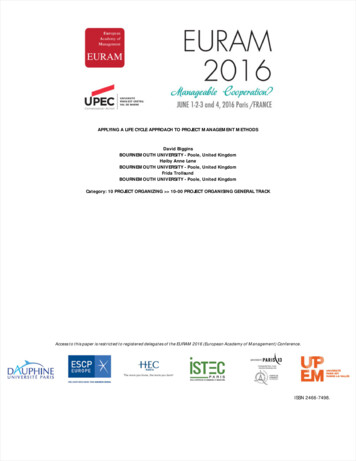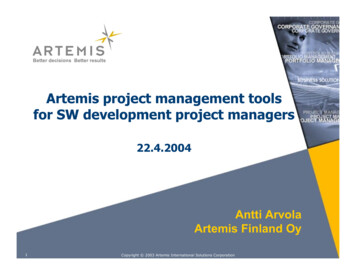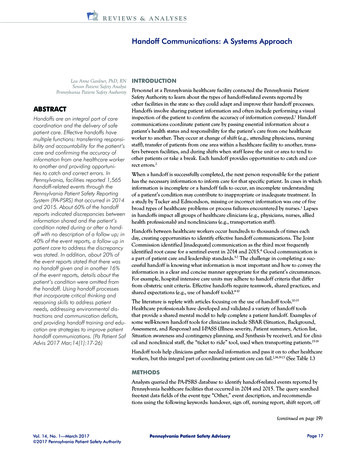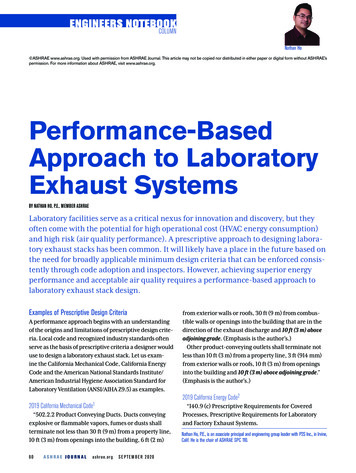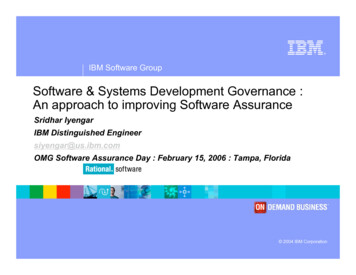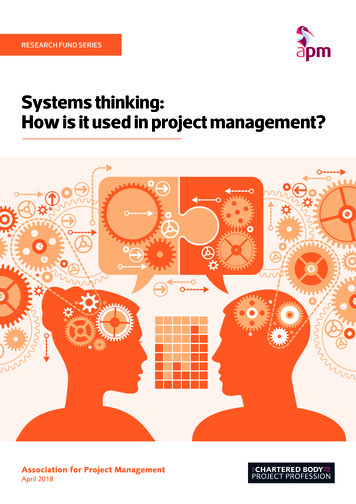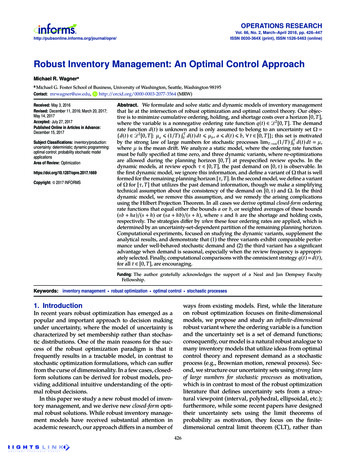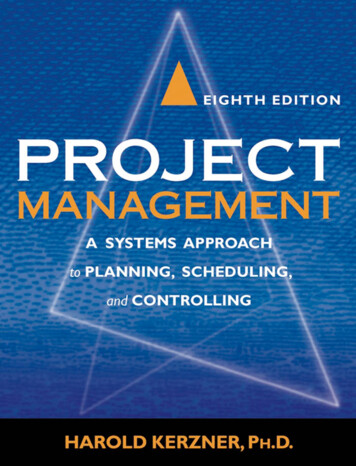
Transcription
PROJECTMANAGEMENTA Systems Approach toPlanning, Scheduling,and ControllingEIGHTH EDITIONHAROLDKERZNER,Division of Business AdministrationBaldwin-Wallace CollegeBerea, OhioJohn Wiley & Sons, Inc.Ph.D.
PROJECTMANAGEMENT
Dr. Kerzner’s 16 Points to ProjectManagement Maturity1. Adopt a project management methodology and use it consistently.2. Implement a philosophy that drives the company toward project management maturity and communicate it to everyone.3. Commit to developing effective plans at the beginning of each project.4. Minimize scope changes by committing to realistic objectives.5. Recognize that cost and schedule management are inseparable.6. Select the right person as the project manager.7. Provide executives with project sponsor information, not project management information.8. Strengthen involvement and support of line management.9. Focus on deliverables rather than resources.10. Cultivate effective communication, cooperation, and trust to achieverapid project management maturity.11. Share recognition for project success with the entire project team andline management.12. Eliminate nonproductive meetings.13. Focus on identifying and solving problems early, quickly, and cost effectively.14. Measure progress periodically.15. Use project management software as a tool—not as a substitute for effective planning or interpersonal skills.16. Institute an all-employee training program with periodic updates basedupon documented lessons learned.
PROJECTMANAGEMENTA Systems Approach toPlanning, Scheduling,and ControllingEIGHTH EDITIONHAROLDKERZNER,Division of Business AdministrationBaldwin-Wallace CollegeBerea, OhioJohn Wiley & Sons, Inc.Ph.D.
This book is printed on acid-free paper. Copyright 2003 by John Wiley & Sons, Inc. All rights reservedPublished by John Wiley & Sons, Inc., Hoboken, New JerseyPublished simultaneously in CanadaNo part of this publication may be reproduced, stored in a retrieval system or transmitted in anyform or by any means, electronic, mechanical, photocopying, recording, scanning or otherwise,except as permitted under Sections 107 or 108 of the 1976 United States Copyright Act, withouteither the prior written permission of the Publisher, or authorization through payment of theappropriate per-copy fee to the Copyright Clearance Center, Inc., 222 Rosewood Drive, Danvers, MA01923, (978) 750-8400, fax (978) 750-4744, or on the web at www.copyright.com. Requests to thePublisher for permission should be addressed to the Permissions Department, John Wiley & Sons, Inc.,111 River Street, Hoboken, NJ 07030, (201) 748-6011, fax (201) 748-6008,e-mail: permcoordinator@wiley.com.Limit of Liability/Disclaimer of Warranty: While the publisher and author have used their best effortsin preparing this book, they make no representations or warranties with respect to the accuracy orcompleteness of the contents of this book and specifically disclaim any implied warranties of merchantabilityor fitness for a particular purpose. No warranty may be created or extended by sales representatives orwritten sales materials. The advice and strategies contained herein may not be suitable for your situation.You should consult with a professional where appropriate. Neither the publisher nor author shall be liablefor any loss of profit or any other commercial damages, including but not limited to special, incidental,consequential, or other damages.For general information on our other products and services or for technical support, please contact ourCustomer Care Department within the United States at (800) 762-2974, outside the United States at (317)572-3993 or fax (317) 572-4002.Wiley also publishes its books in a variety of electronic formats. Some content that appears in print may notbe available in electronic books. For more information about Wiley products, visit our web site at www.wiley.com.Library of Congress Cataloging-in-Publication Data:Kerzner, Harold.Project management : a systems approach to planning, scheduling, and controlling /Harold Kerzner.--8th ed.p. cm.Includes bibliographical references and indexes.ISBN 0-471-22577-0 (cloth : alk. paper)1. Project management. I. Title.HD69.P75 K47 2002658.4 04--dc212002028892Printed in the United States of America.10987654321
ToDr. Herman Krier,my Friend and Guru,who taught me well themeaning of the word “persistence”
on 1Understanding Project Management 2Defining Project Success 6The Project Manager–Line Manager Interface 7Defining the Project Manager’s Role 9Defining the Functional Manager’s Role 11Defining the Functional Employee’s Role 14Defining the Executive’s Role 14Working with Executives 15The Project Manager as the Planning Agent 16Project Champions 17The Downside of Project Management 18Project-Driven versus Non–Project-Driven Organizations 19Marketing in the Project-Driven Organization 21Classification of Projects 23Location of the Project Manager 24Differing Views of Project Management 26Concurrent Engineering: A Project Management Approach 27Problems27Case StudyWilliams Machine Tool Company30vii
viiiCONTENTS2PROJECT MANAGEMENT GROWTH: CONCEPTS 2.112.122.132.142.152.16Introduction 33General Systems Management 34Project Management: 1945–1960 34Project Management: 1960–1985 35Project Management: 1985–2003 47Resistance to Change 51Systems, Programs, and Projects: A Definition 55Product versus Project Management: A Definition 58Maturity and Excellence: A Definition 59Informal Project Management: A Definition 60The Many Faces of Success 61The Many Faces of Failure 64The Stage-Gate Process 67Project Life Cycles 69Project Management Methodologies: A Definition 75Change Management and Corporate Cultures 77Systems Thinking 82Problems385ORGANIZATIONAL STRUCTURES873.0Introduction 873.1 Organizational Work Flow 903.2Traditional (Classical) Organization 913.3Developing Work Integration Positions 943.4Line–Staff Organization (Project Coordinator) 983.5Pure Product (Projectized) Organization 993.6 Matrix Organizational Form 1023.7Modification of Matrix Structures 1113.8Center for Project Management Expertise 1153.9Matrix Layering 1153.10 Selecting the Organizational Form 1173.11 Structuring the Small Company 1243.12 Strategic Business Unit (SBU) Project Management3.13 Transitional Management 128Problems130Case StudyJones and Shephard Accountants, Inc.136127
ixContents4ORGANIZING AND STAFFING THE PROJECT OFFICE 124.13Introduction 139The Staffing Environment 140Selecting the Project Manager: An Executive Decision 142Skill Requirements for Program Managers 148Special Cases in Project Manager Selection 153Selecting the Wrong Project Manager 154Next Generation Project Managers 157Duties and Job Descriptions 159The Organizational Staffing Process 163The Project Office 168The Functional Team 174The Project Organizational Chart 176Special Problems 179Selecting the Project Management Implementation Team 181Problems5184MANAGEMENT FUNCTIONS1915.0Introduction 1915.1Controlling 1935.2Directing 1935.3Project Authority 1975.4Interpersonal Influences2055.5Barriers to Project Team Development 2085.6Suggestions for Handling the Newly Formed Team5.7Team Building as an Ongoing Process 2155.8Leadership in a Project Environment 2165.9Life-Cycle Leadership 2175.10 Organizational Impact 2205.11 Employee–Manager Problems 2215.12 Management Pitfalls 2255.13 Communications 2275.14 Project Review Meetings 2375.15 Project Management Bottlenecks 2375.16 Communication Traps 2385.17 Proverbs 2405.18 Management Policies and Procedures 240Problems243Case StudiesThe Trophy Project253213
xCONTENTSLeadership Effectiveness (A) 254Leadership Effectiveness (B) 259Motivational Questionnaire 2656TIME MANAGEMENT AND STRESS6.06.16.26.36.46.5273Introduction 273Understanding Time Management 274Time Robbers 274Time Management Forms 276Effective Time Management 277Stress and Burnout 278Problems280Case StudyThe Reluctant uction 283Objectives 284The Conflict Environment 285Conflict Resolution 288Understanding Superior, Subordinate, and FunctionalConflicts 289The Management of Conflicts 291Conflict Resolution Modes 292Problems294Case StudiesFacilities Scheduling at Mayer Manufacturing 297Telestar International 299Handling Conflict in Project Management 3008SPECIAL TOPICS8.08.18.28.38.4307Introduction 307Performance Measurement 308Financial Compensation and Rewards 315Effective Project Management in the Small BusinessOrganization 321Mega Projects 323
xiContents8.58.68.78.88.9Morality, Ethics, and the Corporate CultureInternal Partnerships 327External Partnerships 328Training and Education 330Integrated Product/Project Teams 333Problems9344352WORKING WITH EXECUTIVES10.010.110.210.3339Introduction 339Predicting Project Success 340Project Management EffectivenessExpectations 345Force Field Analysis 346Lessons Learned 351Problems10335THE VARIABLES FOR SUCCESS9.09.19.29.39.49.5353Introduction 353The Project Sponsor 354Handling Disagreements with the SponsorThe In-House Representatives 363Problems324363364Case StudyCorwin 1.711.811.911.1011.11368377Introduction 377General Planning 380Life-Cycle Phases 382Proposal Preparation 386Understanding Participants’ Roles 386Project Planning 387The Statement of Work 388Project Specifications 393Milestone Schedules 395Work Breakdown Structure 396WBS Decomposition Problems 402Role of the Executive in Project Selection406
911.2011.2111.2211.2311.2411.2511.26Role of the Executive in Planning 410The Planning Cycle 411Work Planning Authorization 412Why Do Plans Fail? 413Stopping Projects 414Handling Project Phaseouts and Transfers 415Detailed Schedules and Charts 416Master Production Scheduling 419Program Plan 421Total Project Planning 426The Project Charter 430Management Control 431The Project Manager–Line Manager Interface 434Fast-Tracking 436Configuration Management 437Problems12438NETWORK SCHEDULING ction 449Network Fundamentals 452Graphical Evaluation and Review Technique (GERT)Dependencies 456Slack Time 457Network Replanning 463Estimating Activity Time 467Estimating Total Program Time 468Total PERT/CPM Planning 469Crash Times 471PERT/CPM Problem Areas 475Alternative PERT/CPM Models 476Precedence Networks 478Lag 481Understanding Project Management Software 482Software Features Offered 482Software Classification 484Implementation Problems 485Problems486Case StudyCrosby Manufacturing Corporation494456
xiiiContents13PROJECT GRAPHICS13.013.113.213.313.4Introduction 497Customer Reporting 498Bar (Gantt) Chart 499Other Conventional Presentation TechniquesLogic Diagrams/Networks 509Problems14497510PRICING AND 1Introduction 511Global Pricing Strategies 512Types of Estimates 513Pricing Process 516Organizational Input Requirements 519Labor Distributions 520Overhead Rates 524Materials/Support Costs 526Pricing Out the Work 529Smoothing Out Department Man-Hours 530The Pricing Review Procedure 532Systems Pricing 534Developing the Supporting/Backup Costs 535The Low-Bidder Dilemma 539Special Problems 539Estimating Pitfalls 540Estimating High-Risk Projects 541Project Risks 542The Disaster of Applying the 10 Percent Solution to Project EstimatesLife-Cycle Costing (LCC) 548Logistics Support 553Economic Project Selection Criteria: Capital Budgeting 554Payback Period 554The Time Value of Money 555Net Present Value (NPV) 556Internal Rate of Return (IRR) 557Comparing IRR, NPV, and Payback 558Risk Analysis 558Capital Rationing 559Problems560546
xivCONTENTS15COST 1015.11565Introduction 565Understanding Control 569The Operating Cycle 572Cost Account Codes 573Budgets 580Variance and Earned Value 580Recording Material Costs Using Earned Value MeasurementThe Material Accounting Criterion 601Material Variances: Price and Usage 602Summary Variances 603Status Reporting 604Cost Control Problems 610Problems612Case StudyThe Bathtub Period16TRADE-OFF ANALYSIS IN A PROJECT ENVIRONMENT16.016.116.216.316.417623Introduction 625Methodology for Trade-off Analysis 628Contracts: Their Influence on Projects 645Industry Trade-off Preferences 646Conclusion 649RISK 17.1017.1117.1217.1317.1417.15651Introduction 651Definition of Risk 653Tolerance for Risk 654Definition of Risk Management 655Certainty, Risk, and Uncertainty 656Risk Management Process 661Risk Planning 662Risk Assessment 663Risk Identification 664Risk Analysis 668The Monte Carlo Process 675Risk Handling 681Selecting the Appropriate Response MechanismRisk Monitoring 686Some Implementation Considerations 687The Use of Lessons Learned 688685625598
xvContents17.16 Dependencies between Risks 69217.17 The Impact of Risk Handling Measures 69617.18 Risk and Concurrent Engineering 699Problems703Case StudiesTeloxy Engineering (A)Teloxy Engineering (B)18LEARNING 018.1118.1218.1318.14716733MODERN DEVELOPMENTS IN PROJECT 1Introduction 711General Theory 712The Learning Curve Concept 712Graphic Representation 714Key Words Associated with Learning CurvesThe Cumulative Average Curve 718Sources of Experience 720Developing Slope Measures 723Unit Costs and Use of Midpoints 724Selection of Learning Curves 724Follow-on Orders 726Manufacturing Breaks 726Learning Curve Limitations 727Prices and Experience 729Competitive Weapon 730Problems19709710Introduction
Use project management software as a tool—not as a substitute for ef-fective planning or interpersonal skills. 16. Institute an all-employee training program with periodic updates based upon documented lessons learned. PROJECT MANAGEMENT A Systems Approach to Planning, Scheduling, and Controlling EIGHTH EDITION HAROLD KERZNER, Ph.D. Division of Business Administration

